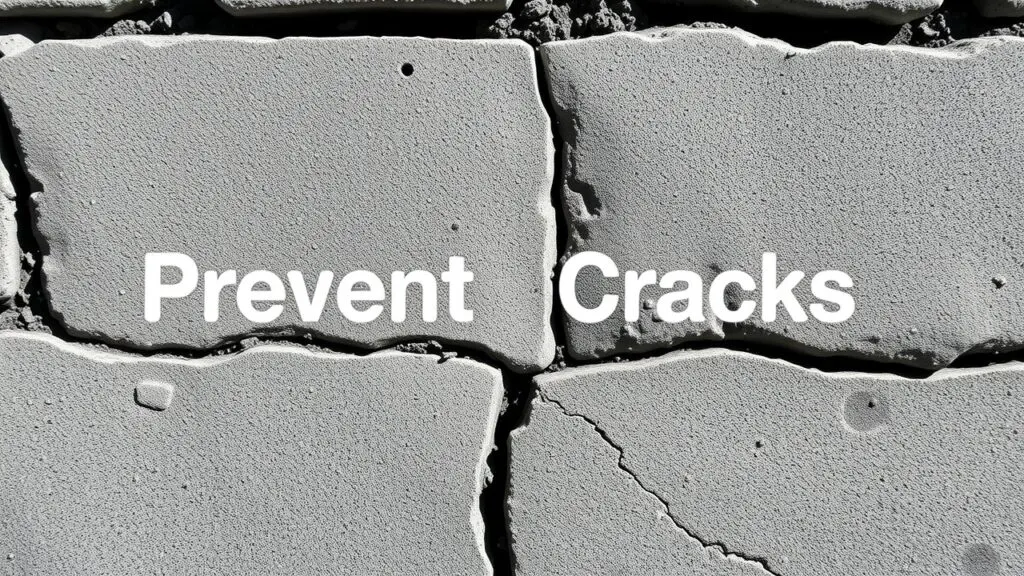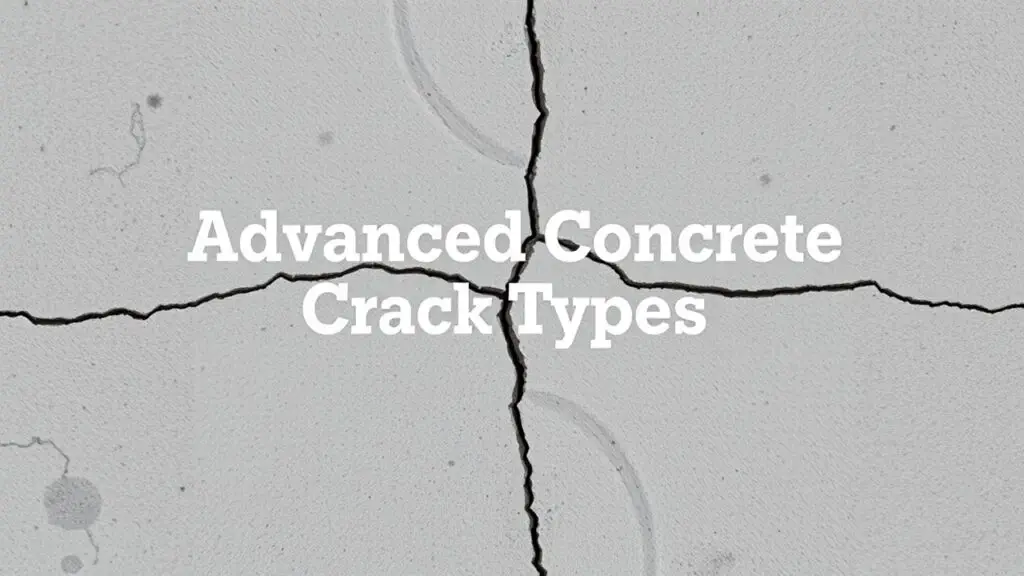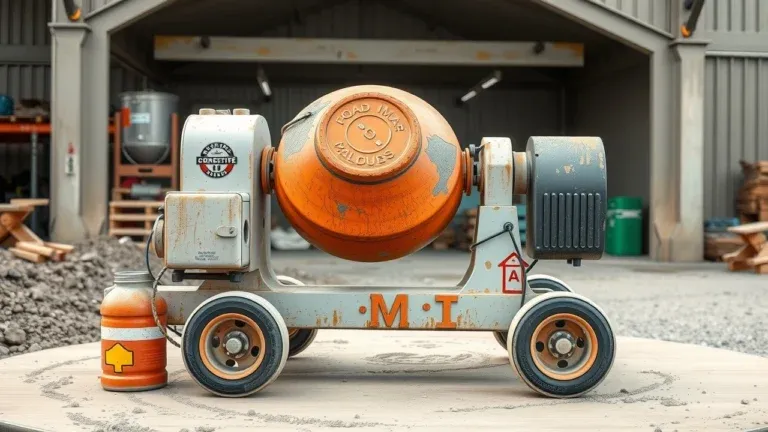Types of concrete cracks are many, from hairline fissures to large splits. This guide covers common crack types, their causes, how to fix them, and steps to prevent future damage.
What Are Concrete Cracks?

Concrete cracks are splits or breaks that show up on concrete surfaces. They happen for many reasons. Changes in temperature and moisture can cause them, along with problems like settling or being overloaded. Knowing what causes these cracks helps figure out how bad they are and how to fix them.
There are several types of concrete cracks:
- Hairline cracks: These are very thin lines that often form when the concrete dries.
- Surface cracks: These only affect the top layer but can mean there are deeper issues if they get worse.
- Deep cracks: These go far into the concrete and may show serious problems that need quick fixing.
- Fine cracks: Similar to hairline cracks but slightly bigger.
A lot of people think that all visible cracks mean there’s big trouble. But that’s not true! Many cracks are just cosmetic and won’t harm your building.
Why Identifying Crack Types Matters?
Knowing the type of crack is super important for safety. Each crack type tells a different story about how strong or weak the structure is. Some might be minor while others could lead to major issues if ignored.
For example, cosmetic cracks like hairline or surface ones usually don’t need much fixing. But structural cracks caused by foundation shifts or heavy stress need to be looked at right away. If you mistake one for the other, it could cost a lot in repairs later.
Understanding if a crack is just for looks or if it shows a deeper issue helps homeowners decide when to fix things or call for help.
Overview of Crack Categories Covered in This Guide
This guide will cover different types of concrete cracking:
- Cosmetic Cracks: These include minor issues like hairline fissures that generally don’t affect strength.
- Structural Cracks: More serious problems come from shifts in the foundation or other big concerns; these need quick attention from experts.
By learning about these categories—like shrinkage-related issues versus those from outside forces—you’ll get clearer ideas about your situation and how best to handle it effectively.
Types of Concrete Cracks Explained
Shrinkage Cracks in Concrete
Shrinkage cracks often appear in concrete when it dries. These cracks can be tiny, known as hairline cracks, and usually do not affect how strong the concrete is. They form because of concrete drying shrinkage, which happens when water evaporates from fresh concrete while it cures.
There are two main types of shrinkage cracks:
- Plastic shrinkage cracks: These occur while the concrete is still wet. They are often caused by fast evaporation on hot or windy days.
- Drying shrinkage cracks: These happen after the surface hardens but before it is fully cured.
Even though these cosmetic cracks can look worrisome, they generally don’t need major repairs unless they grow or cause other problems.
Settlement Cracks in Foundations & Slabs
Settlement cracks happen when there’s movement under a slab or foundation due to soil changes. This type of crack may show differential settlement, where one part of a structure sinks more than another. Factors like bad drainage, expansive soils, or poor compaction during building can make this worse.
If not dealt with, these fractures can affect the structural integrity of your building. Homeowners should watch for signs that might need expert help.
Thermal Expansion & Contraction Cracks
Thermal expansion and contraction are natural processes that occur with temperature changes affecting all materials, including concrete. When it gets hot, concrete expands; when it cools down, it contracts. If this movement is blocked—like by nearby buildings—it may lead to cracking over time.
It’s key to understand how freeze-thaw cycles can hurt your driveway or patio. Repeated freezing and thawing can make these thermal stresses worse and lead to serious damage if moisture gets into existing cracks.
Freeze-Thaw Damage Leading To Spalling / Flaking Surface Layers
Freeze-thaw damage occurs when water seeps into small holes in the concrete and then freezes. When the water freezes, it expands and causes cracking as it thaws. This process is called spalling. Over time, this leads to flaking surfaces that hurt both appearance and strength.
To stop freeze-thaw damage:
- Keep surfaces sealed.
- Ensure good drainage around slabs.
- Use air-entrained mixtures for colder climates during installation.
Taking care of visible spalling right away helps keep the area looking good and lasting longer!
Corrosion Cracks
Corrosion issues mainly come from chemical damage to reinforcement bars (rebar) in reinforced concrete structures like beams or columns. These are often called corrosion cracks. The most common problem comes from sulfate attack due to sulfates in soil or groundwater. This weakens rebar over time and could cause structural failure if repairs aren’t done quickly!
Finding corrosion involves checking for rust stains near joints; these may indicate areas needing urgent attention through proper repair methods that ensure safety during restoration efforts!
Concrete Crack Comparison
Concrete cracks can be a big headache for homeowners. It’s important to know the different types of concrete cracks, what causes them, how they look, and how serious they are. This chart makes it easier to understand and deal with concrete issues.
Shrinkage Cracks
Shrinkage cracks happen when the concrete dries and shrinks. They usually appear as fine lines that spread out randomly. These cracks are mostly just cosmetic unless they become widespread. You can fix them easily with sealants designed for small repairs.
Settlement Cracks
Settlement cracks form when the soil under the concrete shifts unevenly. These can show up as wide breaks in load-bearing walls. If you see these, you should call a pro because they could indicate serious problems. Repair often requires structural intervention.
Thermal Expansion & Contraction Cracks
These cracks arise due to temperature changes. They usually create straight lines across slabs, especially where there aren’t control joints. They’re moderate in severity but can get worse over time if not addressed. Repairs may involve patching with special sealants and adding thermal joints.
Freeze-Thaw Damage
This kind of damage occurs when water seeps into the concrete and freezes. As it freezes, it expands and causes pressure that leads to cracking. You’ll notice layers forming when looking closely at affected areas in colder climates. The severity of this type of damage varies widely based on how often freeze-thaw cycles happen. For small problems, sealing might do the trick, but bigger issues could mean resurfacing or full replacement is needed.
Corrosion Cracks
These occur due to rust forming on steel bars inside the concrete. The rust pushes against the concrete, creating larger cracks that can weaken structures. If you spot these cracks, it’s essential to get a professional opinion since they often need extensive repairs to ensure safety.
By knowing about these types of concrete cracks, you can keep your home safe and sound. You’ll know when it’s time for a quick fix or when to call in the experts for help!
Assessing Crack Severity: DIY vs. Professional Repair
When you see cracks in your concrete, it’s really important to figure out how serious they are. This helps you decide whether to fix them yourself or hire a pro. Knowing how to assess concrete damage can guide your decision.
Factors Affecting Assessment (Crack Width, Length, Pattern, Location)
Several things help you figure out how bad the cracks are:
- Crack Width: The size of the crack matters. If it’s a tiny hairline crack (less than 1/8 inch), it’s usually not a big deal. But if it’s wider, it could mean more serious issues.
- Length: Long cracks that stretch across a large area might point to problems under the surface, like with your foundation.
- Pattern: How the cracks look is also key. Random cracks may come from shrinkage, while straight ones could signal settling issues.
- Location: Where the crack is located matters too. Cracks near doors or windows can be more serious since they might affect structural integrity.
You can use a visual inspection along with measuring tools to check these cracks and see if you need to take action.
When to Call a Professional (Wide Cracks, Structural Concerns, Rapid Propagation)
Here are some signs that mean it’s best to call in a professional:
- Wide Cracks: If any crack is over 1/4 inch wide, reach out to an expert.
- Structural Concerns: Look out for cracks near load-bearing walls or foundations; these can threaten structural integrity.
- Rapid Propagation: If cracks seem to grow fast over time, it could mean ongoing movement that needs urgent attention from a contractor.
Ignoring these signs might lead to expensive repairs later on.
DIY Repair Limits & Benefits of Professional Repair
While some small repairs are fine for DIY methods like patching or using epoxy injections, there are limits:
DIY Repairs:
Good for tiny hairline fractures and minor surface issues.
Cost-effective but may not hold up well without proper techniques.
Professional Repairs:
Best for major damage needing expert knowledge and tools.
Professionals know safety standards and provide solid solutions made just for your problem.
Costs for concrete crack repair vary based on how serious the damage is. However, spending on professional services can save money down the road by addressing the root cause instead of just covering up problems.
Preventing Concrete Cracks: Best Practices
Preventing concrete cracks is key to keeping your surfaces strong and looking good. Here are some best practices to help you avoid cracking.
Proper Concrete Mix Design
A good concrete mix is super important to prevent cracks. The water-cement ratio is a big factor; using too much water can weaken the mix. This can cause shrinkage when it dries. You want a balanced ratio that gives strength without too much water. Also, think about the aggregate type you use. Coarse aggregates work better than fine ones because they make the concrete more stable and reduce cracks.
Adding concrete additives can boost durability and make your mix easier to work with. These might include plasticizers or fibers, which help cut down on shrinkage while curing.
Curing
Doing proper concrete curing is really important. It helps keep moisture in the fresh concrete so it can get strong over time. If the surface dries too fast, cracks can happen later on. Use methods like covering with wet burlap or applying curing compounds to keep things moist while the concrete hardens.
Taking time for proper curing lowers the chances of future concrete cracks from drying too quickly or temperature changes.
Joint Placement
Placing control joints and expansion joints in the right spots helps reduce cracking risks. Control joints let your slab move when temperatures change or if the ground settles. Expansion joints help with natural expansion due to heat.
When deciding where to put these joints, space them out properly—usually every 10-12 feet—and place them where stress might build up, like corners.
Drainage
Good drainage is super important for preventing water damage and freeze-thaw cracking in concrete. If water collects around your foundation, it can seep into cracks over time and cause problems.
Make sure your property slopes away from buildings and install drains if needed to keep water away from areas like driveways or patios that could be at risk of moisture issues.
Regular Inspections
Check your concrete often to catch any signs of damage early on before they turn into bigger problems that need expensive repairs. Look for things like hairline cracks or uneven surfaces during inspections.
Finding these small issues quickly allows for repairs that stop larger cracks from forming later on.
Advanced Crack Types & Causes

Plastic Settlement Cracks
Plastic settlement cracks happen when fresh concrete dries and shrinks before it sets fully. These hairline cracks show up on new slabs, especially if the curing isn’t managed well. Hot weather or not enough moisture can cause these cracks. To avoid plastic settlement cracks, use proper curing methods like curing compounds or covering the slab with wet burlap.
Expansion Cracks
Expansion cracks form when concrete expands or contracts due to temperature changes. When it gets hot, the concrete grows; when it cools, it shrinks. If there’s not enough space for this movement, often because of bad design or missing expansion joints, cracks will occur. Check your concrete surfaces regularly for signs of expansion to catch issues early.
Heaving Cracks
Heaving cracks happen because of ground movement under a slab. This usually comes from soil settling or frost heave in winter. When soil freezes and thaws, it expands and contracts, which puts uneven pressure on the slab above, causing cracking. Homeowners should watch areas where water pools near foundations since too much moisture can make these problems worse.
Overloading Cracks
Overloading cracks occur when a structure carries more weight than designed for, affecting its load-bearing capacity and structural integrity over time. These cracks may appear suddenly under heavy loads like big vehicles parked on driveways or poorly distributed weights inside buildings. Always follow load limits in construction guidelines to prevent these cracks.
Premature Drying Cracks (Crazing and Crusting)
Premature drying leads to two specific types of surface cracking: crazing and crusting.
- Crazing shows up as fine network patterns.
- Crusting involves larger flakes breaking off the main surface.
Both happen due to rapid drying during initial setting without enough moisture to keep things steady.
Chemical Reaction Cracks
Chemical reactions in concrete can also cause damage:
- Alkali-Aggregate Reaction (AAR) occurs when alkalis react with certain aggregates, causing swelling that leads to internal pressure.
- Alkali-Silica Reaction (ASR) affects silica-rich aggregates as it creates expansive gel that weakens the structure.
- Sulfate Attack occurs when sulfates in groundwater react with cement components, leading to volume changes that cause cracking.
Knowing about these chemical processes helps homeowners recognize risks related to their local environment’s chemistry affecting structures.
Spalling Cracks
Spalling occurs mainly due to freeze-thaw cycles. Water gets into tiny pores in cured concrete and freezes, expanding significantly before thawing out again. This process creates flaking layers at the surface known as spalling cracks. If untreated, this can worsen and damage deeper material layers below them requiring costly repairs later!
Stress Corrosion Cracks
Stress corrosion cracking comes from environmental factors combined with mechanical stress on reinforced steel bars in structures that are exposed to moist conditions over time. This allows corrosive agents access to the reinforcement, weakening it and increasing failure points throughout the structure.
Disintegration Cracks
Disintegration happens from wear-and-tear due to harsh elements like rain, snow, wind, and sun exposure over time. This erosion wears away protective layers, exposing the inner core which can lead to more damage unless regular maintenance is done at timely intervals to ensure durability.
| Type | Cause | Appearance |
|---|---|---|
| Plastic Settlement | Concrete drying too quickly | Hairline fractures |
| Expansion | Temperature fluctuations | Long linear splits |
| Heaving | Soil movement | Vertical displacement |
| Overloading | Excess weight | Large fissures |
| Crazing/Crusting | Rapid drying | Surface networks/flakes |
This table sums up various advanced crack types along with their causes and appearances helping readers easily spot issues!
By knowing about these different types of concrete cracks and their causes, homeowners will be better prepared to judge how serious a problem is and what repair methods might be needed so they can maintain their properties well!
Frequently Asked Questions (FAQs)
What are common causes of concrete cracks?
Concrete cracks can result from several factors. Common causes include freeze-thaw cycles, soil settlement, and poor drainage. Chemical attacks can also weaken concrete over time. Overloading concrete slabs with excess weight can lead to serious issues as well.
How do I know if my concrete cracks are serious?
You can assess crack severity by examining width, length, and location. Hairline cracks usually aren’t severe. Wide or deep cracks may indicate structural problems, especially near foundations. Inspecting for signs of moisture ingress is also essential.
What types of advanced cracking exist?
Several advanced types of cracking affect concrete surfaces. These include plastic settlement cracks, crazing, and thermal expansion cracks. Overloading and heaving cracks can indicate issues with load-bearing capacity. Understanding these types helps in proper diagnosis.
What is the importance of concrete curing?
Proper curing enhances concrete strength and longevity. It reduces drying shrinkage and minimizes cracking risks during the hardening process. Good curing practices involve maintaining moisture and temperature control for optimal results.
Concrete Cracking: Types and Causes
- D-Cracking: Affects concrete surfaces near joints due to moisture damage.
- Stress Corrosion Cracks: Caused by environmental exposure to moisture on steel reinforcements.
- Overloading Cracks: Result from placing excessive weight on slabs.
- Heaving Cracks: Occur from soil expansion or frost heave beneath the slab.
- Crazing Cracks: Form a network of fine surface fractures due to rapid drying.
- Crusting Cracks: Larger flakes form when the surface dries too quickly.
Concrete Repair Techniques
- Crack Injection: Uses epoxy or polyurethane for filling deep cracks.
- Moisture Control: Prevents water damage leading to deterioration.
- Concrete Patching: Repairs small surface damages efficiently.
- Structural Strengthening: Enhances integrity through reinforcing methods.
Best Practices for Concrete Maintenance
- Maintain proper drainage around concrete surfaces.
- Inspect regularly for signs of damage or deterioration.
- Use control joints during installation to manage expansion and contraction.
- Select appropriate concrete mix designs to reduce cracking risks.
These points cover various aspects of types of concrete cracks while incorporating remaining keywords effectively into the content.
Related Topics
- Types of Concrete Crack Repairs
- Types of Concrete Crack Causes
- Types of Concrete Additives
- Types of Concrete Curing Methods
- Types of Soil Affecting Foundations
- Types of Concrete Joint Placement
- Types of Concrete Damage
- Types of Concrete Mix Designs
- Types of Concrete Surface Treatments
- Types of Concrete Failures
- Types of Chemical Reactions Affecting Concrete



Types of Concrete Cracks: Causes, Repair & Prevention